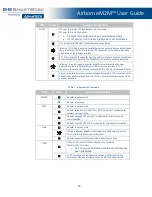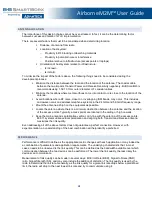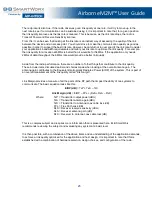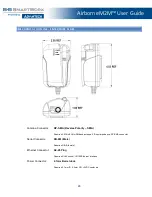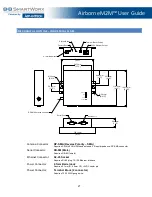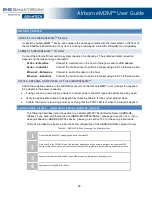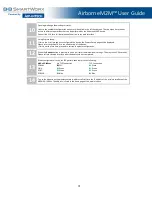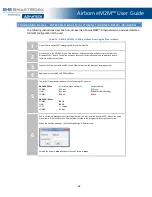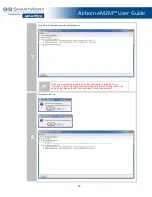
AirborneM2M™ User Guide
23
HOST CHASSIS MOUNTED ANTENNA
Host Chassis mounted antennas require no work on the host PCB. They utilize an antenna type called
‘flying lead’. There are two types of flying leads: one that provides a bulkhead mounted antenna connector
and one that provides a bulkhead mounted antenna. The type you choose will be determined by the
application.
A flying lead system connects a U.FL coaxial lead to the radio’s U.FL connector. The other end of the coax
is attached to either a bulkhead mounted antenna connector or directly to an antenna that has an integrated
bulkhead mount.
In either of the two cases, using this approach significantly reduces antenna system development effort and
provides greater flexibility in the available antenna types and placement in the host system chassis.
When using the flying lead antenna (integrated bulkhead mounting), there are no connector choice
restrictions for use with the FCC/IC modular certification. However, if the flying lead connector is used, the
same restrictions apply as identified for the Host Mounted Antenna.
There are many suppliers of flying lead antenna and connectors. B+B SmartWorx’ Airborne antenna
product line offers a range of antenna solutions.
EMBEDDED ANTENNA
Use of embedded antennas can be the most interesting approach for M2M industrial and medical
applications. Their small form factor and absence of any external mounting provides a very compelling
argument. There is a downside to this antenna type and it comes with performance. Antenna performance
for all of the embedded options will, in most cases, be less than that achievable with external antenna. This
does not make them unusable but, it will impact choice of antenna type and requires more focus on
placement.
The three main embedded antenna types are PCB embedded, chip (PCB mounted) and flying lead. Each
has its advantages and disadvantages (See Table 13).
Table 13 - Embedded Antenna Options
Antenna Type
Features
Cost
Size
Availability
Performance
PCB Embedded
Lowest
Largest
Custom
Poor
Chip
Low
Small
Standard
Poor
Flying Lead
Low
Small
Standard
Fair
PCB Embedded
– This approach embeds an antenna design into the host PCB. This is very common with
add-in Wi-Fi cards (CF, PCMCIA, SDIO, etc.) as it requires no external connections and is the cheapest
production approach. The lower production cost requires significant development cost and lack of
performance and flexibility.
Chip
– The integration of a chip antenna is simple and requires a relatively small footprint on the host
system. However, it does suffer from the same limitations of flexibility and performance as the PCB
embedded approach. There are relatively large numbers of suppliers of this type of antenna and a range of
configuration and performance options as well.
Flying Lead
– This approach is similar to the flying lead solution for external antennas. The difference is
the form factors are smaller and provide a range of chassis and board mounting options, all for internal use.
This approach suffers less from the performance and flexibility limitations of the other approaches, since the
location of the antenna is not determined by the host PCB design. The assembly of a system using this
approach maybe slightly more complex since the antenna is not necessarily mounted on the host PCBA.










